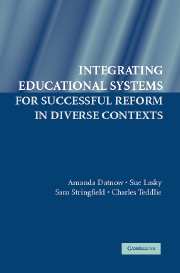Book contents
- Frontmatter
- Contents
- List of Figures and Tables
- Acknowledgments
- 1 Introduction
- 2 School Effectiveness and Improvement
- 3 District-Level Reform Efforts
- 4 Community-Level Reform Efforts
- 5 State-Level Reform Efforts
- 6 The Role of Reform Design Teams
- 7 The Role of the Federal Government in Reform Efforts
- 8 Methodological Issues in the Study of Systemic Integration for Effective Reform
- 9 Discussion and Conclusion
- Bibliography
- Index
7 - The Role of the Federal Government in Reform Efforts
Published online by Cambridge University Press: 02 September 2009
- Frontmatter
- Contents
- List of Figures and Tables
- Acknowledgments
- 1 Introduction
- 2 School Effectiveness and Improvement
- 3 District-Level Reform Efforts
- 4 Community-Level Reform Efforts
- 5 State-Level Reform Efforts
- 6 The Role of Reform Design Teams
- 7 The Role of the Federal Government in Reform Efforts
- 8 Methodological Issues in the Study of Systemic Integration for Effective Reform
- 9 Discussion and Conclusion
- Bibliography
- Index
Summary
Attempting to discuss “the federal lens” on almost any U.S. topic is a daunting task. The United States spans a continent plus islands near the middle of the Pacific Ocean. Our nation includes over two hundred eighty million people living in fifty states plus the District of Columbia. Several U.S. states are larger in terms of land mass, population, and gross domestic product than the average nation in the rest of the world.
The best available anthropological evidence is that perhaps as recently as fifteen thousand years ago there were no human beings on either the North or South American continents (Diamond 1997). From then to now, the ancestors of today's U.S. citizens have arrived in ever-increasing numbers. Some of today's U.S. citizens descend directly from people who arrived twelve thousand years ago, and much larger numbers of our citizens arrived in the past twelve years. The ancestors of today's U.S. citizens spoke thousands of languages, and several of today's school districts serve students who, collectively, are fluent in over one hundred different languages. Not only is the United States the most diverse nation on earth; America today is the most diverse nation in the history of the earth. Attempts to generalize about such a group do not come easily.
In this chapter, the majority of data presented will be descriptive. There is no random assignment to nations or to national policy.
- Type
- Chapter
- Information
- Publisher: Cambridge University PressPrint publication year: 2006



